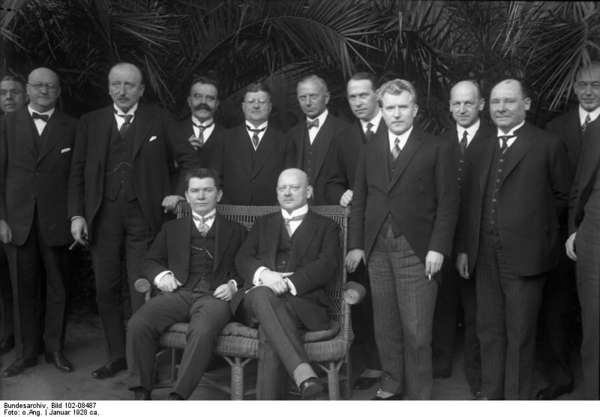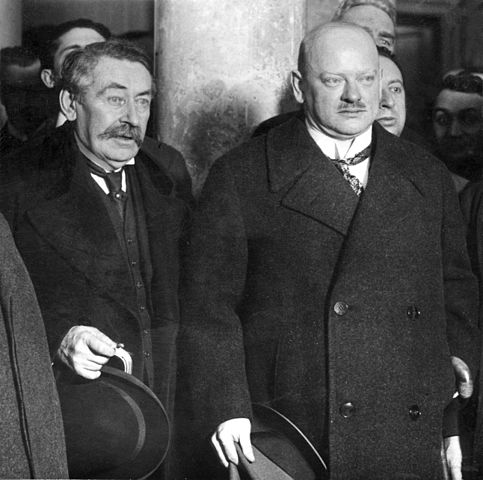Street names: The Stresemannallee in Hamburg - Beyond History’s new address
- 21. January 2018 - General, Germany, Hamburg, History, Knowledge, Personalities
If you haven’t noticed yet, our offices have moved within Hamburg in December 2017: From Cheruskerweg to Stresemannallee. That means, we are now just around the corner from the company Beiersdorf. In the first part of our series on street names, we already talked about its history. It is still located in Troplowitzstraße which is named after one of the owners of the company, Oscar Troplowitz.
Stresemannallee also commemorates a well-known person, the German politician Gustav Stresemann.
The economical lobbyist Gustav Stresemann
It is quite appropriate that Stresemannallee is so near to Beiersdorf and other companies like Nexperia. For the German politician, who might be called one of the most important political personalities of the Weimar Republic, started his career as an industrial lobbyist. Born in Berlin in 1878, Stresemann worked after his studies, amongst others, for the Verband deutscher Schokoladenfabrikanten (Association of German Chocolate Maufacturers), for the Bund der Industriellen (BDI, Union of Industrials) and the Verband sächsischer Industrieller (Association of Saxon Industrials), of which he was a founding member. In 1914, Albert Ballin, the general director of the Hamburg America Line (see here our blog post on the reopening of “BallinStadt” in Hamburg 2016), and Stresemann founded together with other leading German business persons the Deutsch-Amerikanischer Wirtschaftsverband (German-American trade association). Here Stresemann was managing member of the executive committee until 1923.
The politician Gustav Stresemann
Stresemann became a member of the Nationalliberale Partei (National Liberal Party) in 1903. When after World War I the Deutsche Demokratische Partei (DDP, German Democratic Party) was founded in 1918, Stresemann established the Deutsche Volkspartei (DVP, German People’s Party) whose chairman he became. Even though Stresemann opposed the Treaty of Versailles, he took the view that German interests were only enforceable on its grounds. He considered the remaining economy to be Germany’s only source of power. Therefore he worked for a better understanding with the Western forces, especially France.
In 1923, Stresemann became Chancellor of the Reich for a short time. His term of office came at a difficult time of hyperinflation and a radicalization of domestic politics. Afterwards he took over the post of the foreign minister that he exercised until his death in 1929. Amongst others, he contributed to the acceptance of the Dawes-Plan in 1924 that newly regulated the reparation payments. In 1925 he was substantially involved in the negotiation of the Locarno Treaties that defined the borders between Germany, France and Belgium as well as mutual renunciation of violence and Germany’s accession to the League of Nations. In 1926, Gustav Stresemann and his French counterpart Aristide Briand received the Nobel Peace Prize for their reconciliation work.
A „Stresemann“ to wear
Not only various streets throughout Germany are named after Gustav Stresemann, a suit bears his name, too. The “Stresemann” is a suit for formal day wear that can be worn untill around 5 p.m. It is similar to the US-American “Stroller” and originally consisted of black and grey striped pants, a single-row black jacket, a black vest, a white shirt and a tie. Subsequently often a light gray vest and silver tie were chosen.
But how did this suit combination come about? In the early 20th century it was customary to wear a cutaway (or modern morning coat) on state occasions. Due to its formality, it was not suitable for the more normal office routine. It is said that Gustav Stresemann was tired of constantly changing his suit and therefore only changed his jacket for a less formal and shorter one. Gustav Stresemann is supposed to have worn the combination for the first time in 1925 on the occasion of the negotiation and signing of the Locarno Treaties.
In Germany, the Stresemann soon became popular. In the early years of the Federal Republic of Germany it was so often worn during state receptions that it was called “Bonner Anzug” (suit of Bonn, the former German capital). Theodor Heuss and Konrad Adenauer were wearing it for example. Today it is called “Stresemann” once again.



0 comments